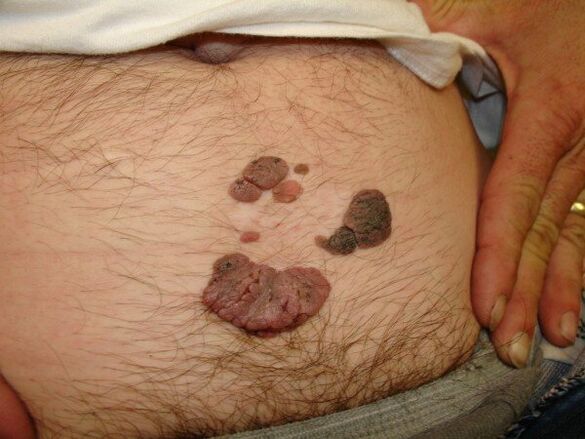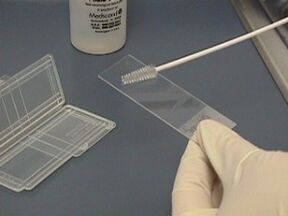Papillomavirus infections are common worldwide. HPV infection occurs regardless of age and gender, but the course of the disease and its development are different in men and women.
For the stronger sex, the papillomavirus can bring certain disruptions in sex life and provoke the emergence of related health problems.
The reasons

The human papillomavirus is so microscopically structured that it can penetrate the body through the smallest microcracks in the skin and mucous membranes.
In this regard, there are several possible HPV infections, these are:
- sexual transmission. You can become infected not only through ordinary intimate contact, but also through oral contact. In homosexual men, HPV enters through anal contact through cracks in the skin and rectum. Traumatizing the mucous membranes during sex increases the risk of infection.
- route of infection in the home. The virus can be in a viable state in a humid environment for a long time, and therefore there is a high probability of transmission in baths, saunas and through a personal towel. Cases of infection in beauty salons, where the rules for disinfecting manicure sets and other utensils were disregarded, are described. Transmission of the virus through instruments in dentists or operating rooms is possible.
- From mother to baby during birth.
Men who frequently switch sexual partners are most likely to become HPV positive.
It is believed that the younger the girls are, the more likely they are to have papillomavirus in their bodies - most cases of proven infection occur by the age of up to 25 years. Virgins can also become infected with HPV, as oral sex and other forms of intercourse often precede traditional sex.
Unfortunately, barrier contraception, i. e. a condom, does not offer a 100 percent guarantee of preventing an HPV infection. This is because this microorganism easily enters through the pores of the latex due to its small size. Of course, a condom reduces the chance of a possible infection, but does not completely eliminate it.
It should also be borne in mind that the microorganism is found in a certain amount in saliva and can therefore be transmitted through kissing.
The risk of possible HPV infection increases in men with bad habits. The likelihood of infection increases with the weakening of the body's defenses, after prolonged treatment, while taking antibiotics.
symptoms
The fact that he is a carrier of the papilloma virus cannot be suspected by a man until the activation of the vital activity of this microorganism occurs. The reason for this change is often the weakening of the immune system function.
Latent transmission of infection lasts from two weeks to a year, in some cases this interval is significantly increased.
Activation of the virus causes some of it to accumulate in a specific location on the skin or mucous membranes. The accumulation and development of papillomavirus alters the functions of epithelial cells and this leads to a tumor-like process.
Papillomas can form on almost any part of our body, most often they are noticeable when they appear on the armpits, face, neck and genitals. Sometimes the process of formation of papillomas is accompanied by itching and burning.

Papillomavirus formations on the body grow in the form of plaques, warts, threadlike bumps on the legs. The greatest danger are genital warts, in men they are located on the penis, can grow around the anus or in the urethra.
Initially, these growths usually look like small pimples, in advanced cases they can fuse together and form a growth that resembles a cauliflower in shape.
In itself, genital warts are only uncomfortable because of a cosmetic defect. However, if they are not removed and generally treated with a papillomatous infection, there is a risk that the altered epithelial cells will degenerate into cancer cells.
Sometimes papillomas are injured during sexual intercourse or careless movements, causing minor bleeding and pain. With the strengthening of the immune system, self-healing often occurs, that is, papillomas disappear or become smaller.
effects
The consequences of infection with the papillomavirus for men are very unpleasant and depend on the strain of this microorganism.
If the inside of the urethra is affected, there is a risk of rapid growth and spread of genital warts in the urethra. This leads to partial or complete blockage, which negatively affects the outflow of urine and affects the development of dysfunction of the urinary organs.
The appearance of growths on the glans penis, around the anus and in the rectum increases the likelihood that a benign formation will become malignant.
Rectal cancer is more commonly detected in men who engage in non-traditional sexual intercourse. During oral sex there is a risk of the formation of papillomas in the throat, which are manifested by various unpleasant sensations.
A man infected with HPV also poses some danger to women around him. For a woman or another sexual partner, such a man is the most likely source of infection. There is a risk of contagion for sisters, mothers, daughters when using a towel, bathing accessories in the family.
diagnostic methods

Diagnosis begins with an examination of the patient's external genitals and entire body.
The doctor must necessarily take an anamnesis, that is, to clarify when the formations appeared on the body, what the patient associates his growth with, and to determine whether there are certain ailments.
To confirm the diagnosis, the patient must pass several tests, these are:
- A swab or scraping of the lining of the urethra.
- PCR test to determine the type of virus and its quantitative content. This analysis is performed after taking a swab, prostate secretion or blood.
- Biopsy - an examination of a sample of tissue taken during the removal of genital warts or at the site of a change in the mucous layer.
- Ureteroscopy helps to visually examine changes in the urethra.
Men with homosexual contacts are advised to examine swabs from the anal area.
Methods of treating papillomavirus in men
The choice of methods of treating human papillomavirus in men depends on which strain of the virus is detected in the man.
If a pathogen with high oncogenic activity is detected, then effective antiviral treatment is prescribed, and in the future it is necessary to constantly repeat the tests.
Papillomas and condylomas are removed from the skin and mucous membranes in various ways. This can be either a traditional scalpel incision, or more modern methods - laser treatment, electrocoagulation, radio wave method.
After removal of papillomas, it is necessary to increase the body's resistance to infection, which will reduce the risk of infection with another type of HPV.
prevention
Prevention of human papillomavirus infection is understandable in sexual relations and, if possible, sexual contacts only with trusted partners. Methods of prevention include observing elementary rules in everyday life, that is, using only your own towel and underwear, following a healthy lifestyle.
Infection can be prevented by vaccination. A special vaccine has been developed against HPV, which is administered three times at a certain interval. Vaccination causes the body to develop immunity to certain strains of papillomavirus.













































































